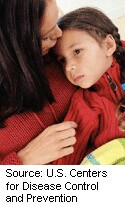
THURSDAY, Nov. 12 (HealthDay News) — At least 22 million Americans have come down with the H1N1 swine flu since the virus first surfaced in April and approximately 3,900 people have died, including an estimated 540 children, federal health officials reported Thursday.
While these numbers represent a significant jump in the numbers of sick, hospitalized and dead from previous figures, they don’t mean that the swine flu has suddenly gotten worse. Instead, the new numbers are based on extrapolations from laboratory-confirmed cases of swine flu. The earlier numbers were based on laboratory-confirmed cases, Dr. Anne Schuchat, director of the U.S. Centers for Disease Control and Prevention’s National Center for Immunization and Respiratory Diseases, said during an afternoon press conference.
“The estimation method we are using now, we believe, gives us probably a more accurate picture of the full scope of the pandemic,” Schuchat said. “What we are seeing in 2009 is unprecedented. As people know, we haven’t had a [flu] pandemic since 1957. To have high rates of influenza in September and October is extremely unusual.”
“We have already seen a larger number of pediatric deaths than we have seen for several years,” she added. “I do believe that the pediatric death toll from this pandemic will be extensive, and much greater than what we see with seasonal flu.”
In a normal year, there are 60 to 80 pediatric deaths from seasonal flu, Schuchat noted.
The figures on pediatric deaths underscore the existing evidence that the H1N1 swine flu poses a particular risk to children and young adults who don’t seem to have immunity to the new strain of disease. Seasonal flu, on the other hand, typically poses a much greater risk to people aged 65 and older.
The statistics released Thursday only run through mid-October, Schuchat said. Swine flu infections have picked up significantly since then.
“We do think we are having a pretty severe number of deaths from this H1N1 virus,” Schuchat said. “Of course, the numbers I am giving are only for the first six months and we have had a lot of disease since then and we will probably have a lot of disease going forward.”
Schuchat also offered the following statistics:
- An estimated 8 million children under age 18 have been infected by the swine flu.
- An estimated 98,000 Americans have been hospitalized by the swine flu, including 36,000 children.
- Among adults, there have been 12 million cases on infection, 53,000 hospitalizations and 2,900 deaths.
- Among those 65 and older, there have been 2 million infections, 9,000 hospitalizations and 440 deaths.
Schuchat said vaccination is the best protection against the H1N1 swine flu. As of Thursday, there were 41.6 million doses of the vaccine available.
Original estimates had put the vaccine supply at 40 million doses by the end of October and 190 million doses by the end of the year. Schuchat said she couldn’t speculate on how much vaccine would be available and when, but she added that she hoped the shortage would be over soon.
High-risk candidates for the vaccine remain children and young adults, pregnant women, and people with chronic medical conditions such as asthma, diabetes and heart disease. Health-care workers and people who care for infants are also high on the vaccine list.
One group that Schuchat singled out Thursday for vaccination are people with diabetes, who make up 12 percent of those hospitalized for swine flu. She urged diabetics to get a swine flu shot and also the vaccine to protect them from pneumonia, a common complication from flu.
Diabetics, like others with chronic conditions, should see their doctor at the first signs of flu symptoms and be treated with the antiviral drug Tamiflu, Schuchat said.
Also Thursday, a study released in this week’s CDC publication Morbidity and Mortality Weekly Report said that seasonal flu shots had no effect either in preventing or increasing the chances of getting the swine flu.
The researchers recommend that people need both seasonal and swine flu shots to protect themselves.
So far, 94 million doses of seasonal flu vaccine have been distributed. Manufacturers plan to have an additional 18 million doses available early next year, Schuchat said.
More information
For more on H1N1 swine flu visit, visit the U.S. Department of Health and Human Services.

